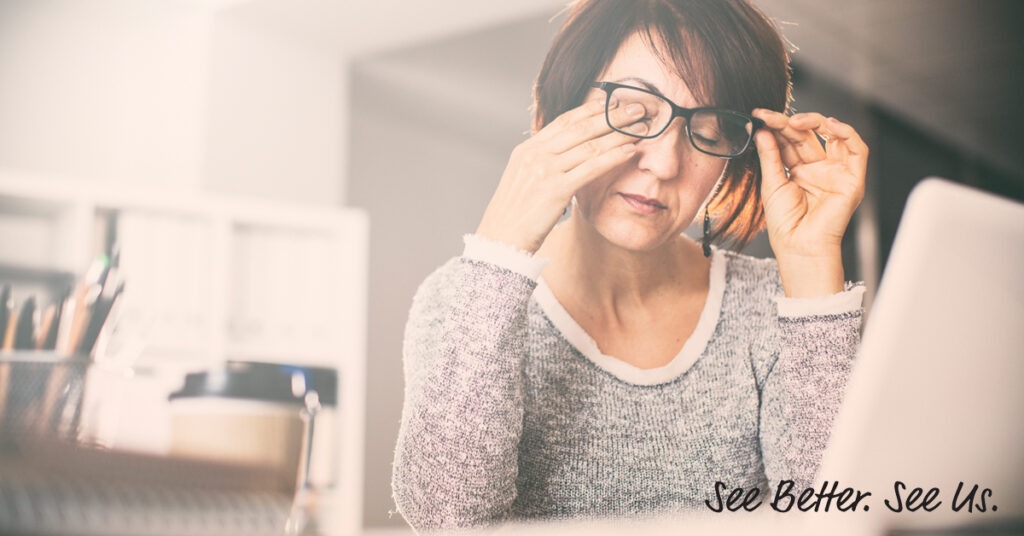Working from home? How you can look after your eyes!

With the outbreak of COVID-19 resulting in many people now working on their screens from home, we have prepared a list of ways that you can help to look after and care for your eyes.
Digital has become an inseparable part of everything we do. It has changed the way we work, learn, shop, socialise and relax; however, our eyes are not accustomed to the changes of the modern life and it is causing a real strain on many of us. The proliferation of devices and growing usage rates creates the question; how will our vision adapt?
Digital Eye Strain can be at the root of strained eyes, neck and shoulder pain as well as headaches – and that there are simple solutions to ease the strain.

Woman Straining Digital Eye Strain
WHAT ARE THE SYMPTOMS OF DIGITAL EYE STRAIN?
- Neck, shoulder and back pain
- Eye Strain
- Headaches
- Blurred Vision
- Dry Eyes
WHY DOES DIGITAL EYE STRAIN OCCUR?
- Our eyes are focusing more intensively, switching frequently between devices and adjusting to increasingly smaller, pixelated and glowing screens
- Digital devices are backlit and emit blue-violet light that can cause strain and discomfort and is linked to disrupted sleeping patterns
- The normal blinking rate is often reduced from 17 or more blinks a minute to 8-10 blinks, reducing tear production, making your eyes feel dry and uncomfortable
- Our posture has changed as we lean toward our screens and/or slouch in our chairs, putting a strain on the neck and back.
1. EXERCISE YOUR EYES.
- Your eyes are like any other muscle, they need exercise. Make sure you are taking breaks from your screen every 20 minutes and give your eyes a break and a routine. Moving your eyes around, looking at varying objects both distant and close, closing and massaging your eyes, and repeating this five to 10 times can give your eyes the exercise and break they need from intense screen light. This simple yet effect step only takes 2 minutes and considerably helps in reducing eye strain and related symptoms.
2. ADJUST YOUR EYES AND YOUR SETTINGS.
- Explore settings on your digital devices and try different font sizes, screen contrasts and brightness, until you find a balance that is easy on you and your eyes. Most technologies now feature a low screen mode that helps in reducing Blue Light by emitting a yellow light.
3. TAKE YOUR EYES ON A WALK.
- Exposing your eyes, mind and body to daylight will help give your eyes a break from the screen, natural light helps your sleep cycle and improve your mood and alertness. If you are able and in a position where you can walk in your own home garden or vanadar, sunlight can make all the difference to improving your posture and mood after long hours have been spent at the computer screen. Make sure to wear sunglasses from protection from glare and natural blue light caused by sunshine.
4. INVEST IN TAKING CARE OF YOUR EYES
- If you are spending long periods of time on the computer and are finding you suffer from eye strain, make sure you are taking the appropriate steps to look after your eyes. This includes wearing sunglasses while outside, and wearing your prescription optical glasses as you have been advised by our optometrist.
Sitting at the computer for too long is not only harmful to your eyes. It can cause stiffness and pain in the rest of your body, too. Avoid this by getting up and moving around on a regular basis.
- Every 10 minutes, take a short 10-20 second break by getting out of your computer chair and moving around.
- Every 30-60 minutes, take a 2-5 minute break to stretch your arms, back and neck and walk around.







